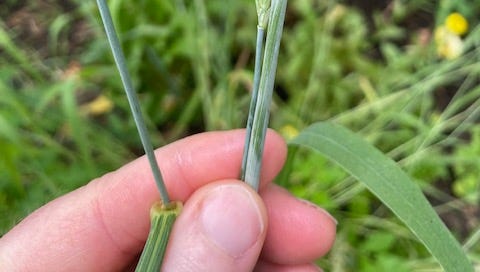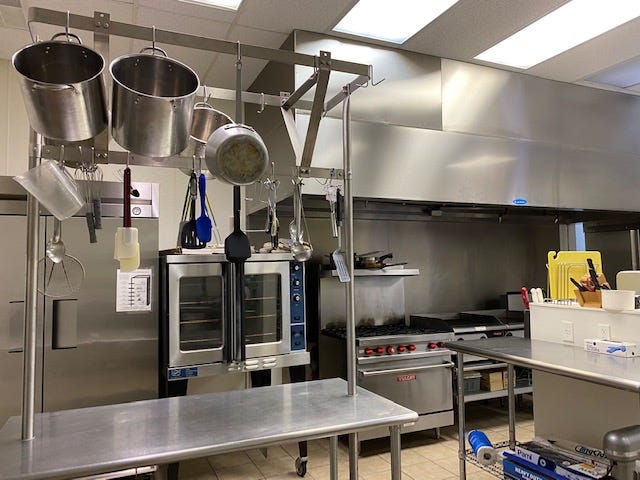My 100th post: grow a grain garden (plus bakery!)
Celebrating this 100th post by sharing that I’m starting a microbakery.
Some of the links in this post are affiliate links. I make a small commission from purchases made through these links, at no cost to you. I share products that I know and use.
I’m a week shy of my 1-year blog anniversary and this week’s special announcement: I’m starting a seasonal microbakery. I’ve wanted to have a small-scale, home-based food business for many years. (Seriously, I attended a workshop from the NC Department of Agriculture 14 years ago!) However, North Carolina’s home-based food business laws require no pets. Instead of building a separate structure, I’ve looked into renting commercial kitchens, but their locations were never convenient. The cost was also prohibitive for the very small-scale production that I want. Over the past year I’ve organized paperwork, insurance, found and toured an affordable kitchen I intend to rent, and refined several of my favorite bread recipes. I’ve been baking bread for 17 years and have a few staples that I’d love to share. If you’re not familiar with the term “microbakery”, it’s a model focused on high-quality, small-batch products. As a seasonal microbakery, I only intend on offering breads in the fall and winter when the bees and garden aren’t taking up my spare time. This is such a tiny scale that I imagine a handful or less of “bread drops” during the beekeeping off-season. The breads (if sweetened) will only be sweetened with honey from my bees—no refined sugars. All of the flours and grains will be milled in North Carolina and certified organic—and some may be grown by me. I’ve experimented with growing grains for a few years. Today’s post is about grain gardening. As far as the bakery, I’ll share the name and more details in the fall.
A combination of hybridization, soil loss, and glyphosate contribute to nutritional deficits and potential health concerns with modern wheat. According to NUTRITION REVIEWS, globally, wheat is the primary nutrition source for humans. At such a mass scale, production has been streamlined to the point where “modern wheat depends on synthetic fertilizer and herbicides that damage our health, land, water, and environment.”
The waning nutritive integrity in modern wheats is associated with a term called “hidden hunger.” While people may be eating meals, their bodies are starving for nutrients. This prolonged state of latent hunger could contribute to chronic issues. (ICYMI, see my earlier post about ways to make your money go farther with avoiding nutrient-deficient foods.)
Modern wheats are dried before harvest with glyphosate. According to the US’ current food label requirements, food producers have no obligation to disclose if glyphosate was used. As a likely carcinogen, glyphosate gained headline exposure during high-profile cancer trials. Learn more about glyphosate facts and labeling in my post about food labels.

Most of these realities, plus my love of baking bread, fueled my interest in growing my own wheats and grains. My trial experiences so far revealed that an abundance of food can come from a small space, the grains require relatively little-to-no maintenance to grow, and many serve as a fantastic cover crop. Wheats as cover crops help to stabilize the soil, cycle nutrients, aerate the soil (especially if their roots are left in place to decay), and shades the soil helping to retain moisture and attract and sustain soil biology. Winter wheat was one of the first things I seeded in my initial garden to help build soil.
What I’m growing in my grain garden today
Turkey red winter wheat
Heirloom wheat, also referred to as a heritage grain, implies that its genetics came long before modern wheat breeding and hybridization. Turkey red winter wheat, a heritage grain, was allegedly brought to the American Wheat Basket in the 1870s. As the name implies, it grows over the winter. According to the Rodale Institute, Turkey red wheat has more phosphorus, potassium, magnesium, and calcium than modern wheat (Triticum aestivum). I discovered Turkey red several years ago through Red Trail Grains. It was fantastic to bake with and I wanted to try and grow my own—which I have for the past few years. I seed this variety in the fall and harvest in late spring.
Blue emmer wheat
Naturally low in gluten, blue emmer is an ancient wheat known as “the ‘mother grain’ of all modern durum wheat” according to Bluebird Grain Farms. This fast-growing early season wheat matures in about 80 days. I seed this one in late winter and harvest in the spring.
Hulless oats
Oats aren’t just for oatmeal or baking. Milky oats, the fresh pods, have medicinal properties, and the stems (oatstraw) are used in teas. According to Mountain Rose Herbs, “There are many nutritional and health benefits found in the oat grain itself and it is often attributed to having the same soothing and nourishing effects as the oatstraw tea and the milky oats tincture.” I discovered this variety while searching for an oat that would provide an easier harvest process. The dried pods on this variety are easier to thresh at harvest time. Because my favorite day of the year (and the anniversary of this blog) is the summer solstice, I like to plant oats in March—close to the spring equinox—so that they’re ready to harvest on the summer solstice.
Black hulless barley
I’m always a fan of purple or black varieties of edible plants because it’s a sure sign of high antioxidant levels. (I also prefer growing what’s not commonly on store shelves.) I seed this around the same time as oats, and then sow a succession harvest around the solstice for late summer harvest.
Coral sorghum
I’m growing this for the first time right now. I acquired the seeds through the Appalachian Seed Growers Collective. I not only love to support their organization, but this sorghum has multiple uses. While the grains can be ground into flour, you can also pop them like corn. They can also be cooked like polenta or rice, or used as many sorghums are in the South: for sorghum syrup (also known as molasses). You may remember from earlier posts that I like sourcing plant varieties that have multiple purposes and also multiple “heads”—like multi-headed sunflowers. Coral sorghum produces multiple stalks from a single seed. I currently have these in seedling containers and plan to transplant this week. It’s drought tolerant, so I won’t need to plant near irrigation lines.
‘Love Lies Bleeding’ amaranth
Out of (maybe irrational?) paranoia that this will spread, I’ve grown this exclusively in containers. The young leaves are also edible, containing three times more calcium than spinach, so you get an appetizer before the grains produce. It loves the heat and is also drought tolerant, maturing in less than 70 days. I sow this in June for a late summer harvest.
Cherry vanilla quinoa
I mentioned quinoa in an earlier post about growing snacks for our backyard chickens. According to the Poultry Extension, quinoa has “high levels of phosphorus, iron, and B vitamins than corn, barley, wheat, and oats.” Similar to amaranth, the young leaves are also edible. It takes about a month longer than amaranth to produce.
White sesame
I’m growing this for the first time right now also. The seedlings struggled with a few hot days and only 1 has survived. I’m sowing a few more this week. I’m using the summer to see how it grows and what it needs. Another heat-loving and drought-tolerant variety. This one has a much longer growing season—about 4 months to maturity.
Mill your own grains
Two years ago I treated myself to a NutriMill countertop grain mill. This not only allows me to process grains that I grow, but also different varieties of wheat berries that I can buy in bulk at our local co-op grocer and online. You may have already picked up that I love variety. Blending various grains gives breads and other things I bake extra depth and texture, not to mention nutrients.





